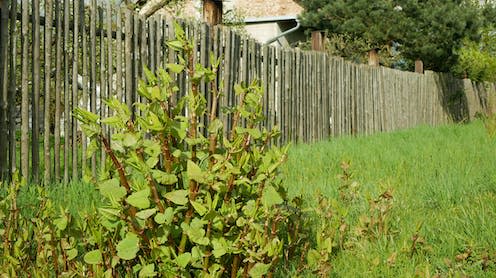What's the most sustainable way of dealing with Japanese knotweed? Here's what we found

When it was introduced to Europe in the mid-19th century as an ornamental plant, Japanese knotweed, known as Reynoutria japonica var japonica, quickly went rogue. Despite not being native to the British Isles, it was able to rapidly form self-sustaining colonies in the wild.
Today, this invasive plant is found across much of Britain and Ireland. It is often spotted growing in areas influenced by people such as waste ground, along riverbanks, roadsides and railway lines.
From an ecological perspective, this plant is very competitive and decreases biodiversity. This means invaded habitats become degraded and we see fewer native plants and animals.
Controlling knotweed is a legal requirement in the UK and the costs of managing it are estimated to be around £165 million per year. Its management on construction sites can cost £1,000 per square meter or more. These costs also impact home and landowners and several legal cases associated with knotweed have made headlines recently.
An entire industry has been built around knotweed management. But until fairly recently, the most effective way of controlling knotweed was unknown. Back in 2018, our research group published the results of the world’s largest Japanese knotweed trial, which is what informs how we currently tackle the plant.
Sustainability
Sustainability has never been a more important issue and there’s increasing pressure to find more sustainable management approaches to dealing with knotweed. Growing concerns around the use of herbicides for the environment and human health have led to an increased focus on physical control methods, such as digging and using geomembranes. These are synthetic liners which stop Japanese knotweed and other unwanted plants from growing by sealing the earth.
However, when we think about sustainable knotweed management, we tend to focus on the immediate impacts, but that is just the tip of the iceberg. What happens before and after we use products to control knotweed is also important. All products and processes have a life cycle and each stage has different impacts. So, the sustainability of alternative approaches to tackling knotweed is often unclear.
To address this, we investigated the impacts of eight Japanese knotweed management methods using life cycle assessment (LCA). That is when you calculate the environmental impact of a product throughout its entire life cycle.
We used our knotweed trial as a reference system for our investigation.

Of the methods assessed, annual glyphosate spraying was the most sustainable option in terms of environmental impacts, economic cost and time consumption. This is because it is an approach that uses the fewest amount of materials while being the most effective method at controlling Japanese knotweed.
We found geomembrane covering to be the most damaging. That was due to the production of the plastics needed to manufacture the geomembranes, as well as the ground preparation needed to install them. And we also found that using digging as part of a knotweed management programme was also less sustainable due to the carbon emissions produced from using machinery.
So, the most effective way of controlling knotweed is also the most sustainable.
In light of the current climate crisis, minimising greenhouse gas emissions is vital. As we are aiming to achieve carbon net zero by 2050 in the UK, we need to think carefully about the sustainability of the approaches we use for managing Japanese knotweed and other problematic invasive plants.
Although we recognise the ongoing discussions regarding the use of glyphosate, its use yields better and more sustainable results than other Japanese knotweed treatments. And understanding the sustainability of different methods also means we can prioritise what we use to control knotweed, which ultimately saves time and money.
One caveat we have is that we evaluated just eight approaches to knotweed management. Assessing environmental impacts relies on comprehensive, long-term data and rigorous record keeping of the time, costs and materials that go into knotweed management. This kind of data can still be hard to come by. But data on the effectiveness and sustainability of different methods will be an essential future consideration for how society selects its weed control treatments.
Our understanding of and ability to quantify the environmental impacts of different products after they have been used is also a growing area of research and something that is not encompassed in our study. This is something we are looking to build upon in the future. It would ensure that different treatments are evaluated in a way that supports the decisions we make as a society over how to control Japanese knotweed.
This article is republished from The Conversation under a Creative Commons license. Read the original article.

Sophie Hocking works for Swansea University. She received funding from Complete Weed Control Ltd as part of her KESS II PhD to support her research.

 Yahoo News
Yahoo News 
